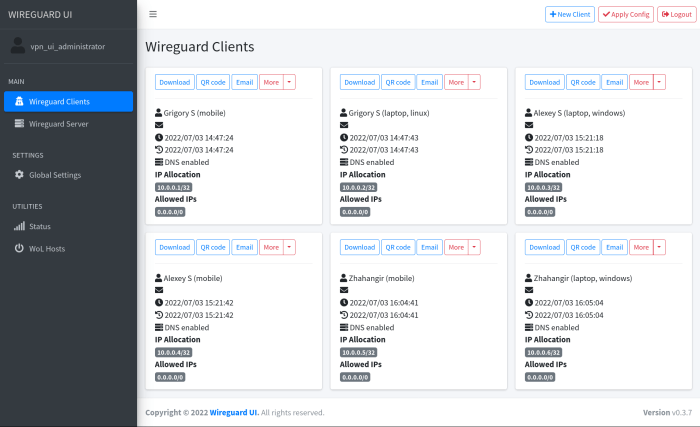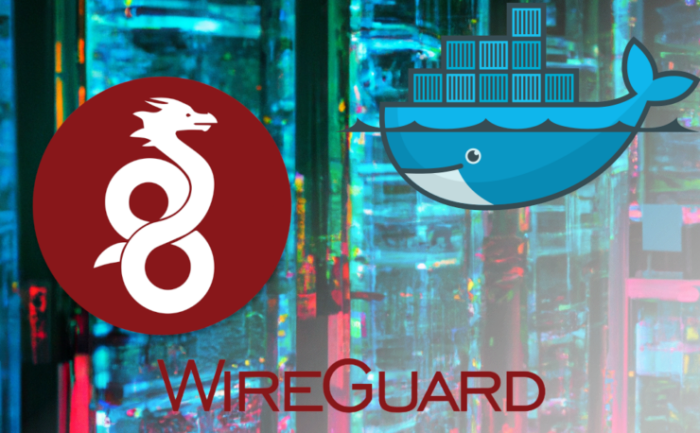In the realm of virtual private networks (VPNs), WireGuard has emerged as a game-changer, offering unparalleled speed, security, and ease of use. When combined with Docker Compose, a powerful container orchestration tool, WireGuard becomes even more versatile and manageable.
This comprehensive guide will delve into the world of WireGuard Docker Compose, exploring its benefits, deployment strategies, configuration options, troubleshooting techniques, security best practices, and advanced topics. Whether you’re a seasoned network engineer or a newcomer to VPNs, this guide will empower you to harness the full potential of WireGuard with Docker Compose.
WireGuard Overview
WireGuard is a cutting-edge VPN protocol that stands out with its simplicity, efficiency, and robust security features. It aims to provide secure and private network communication while surpassing the performance of legacy VPN protocols.
Compared to other VPN protocols like OpenVPN and IPsec, WireGuard offers several advantages. Its lean codebase and streamlined design result in faster connection speeds and lower CPU overhead, making it suitable for resource-constrained devices and high-performance applications.
Key Benefits of WireGuard
- Enhanced speed and performance
- Reduced resource consumption
- Modern cryptography and robust security
- Cross-platform compatibility
Docker Compose for WireGuard

Docker Compose is a tool for defining and managing multi-container Docker applications. It allows you to create a single file that describes all of the containers that make up your application, and then use a single command to start, stop, or rebuild them all.Using
Docker Compose for WireGuard deployment has several benefits. First, it makes it easy to manage multiple WireGuard containers. You can define all of your containers in a single file, and then use a single command to start, stop, or rebuild them all.
This can save you a lot of time and effort, especially if you are managing a complex WireGuard deployment.Second, Docker Compose can help you to ensure that your WireGuard containers are configured correctly. By defining your containers in a single file, you can easily see all of the settings that are being used.
This can help you to avoid errors and ensure that your WireGuard deployment is running smoothly.Third, Docker Compose can help you to deploy WireGuard to multiple hosts. By using a Docker Compose file, you can easily create a deployment that can be deployed to any host that has Docker installed.
This can make it easy to scale your WireGuard deployment to meet the needs of your application.
Creating a Docker Compose File for WireGuard
To create a Docker Compose file for WireGuard, you will need to create a file named docker-compose.yml in the directory where you want to run your WireGuard containers. The following is an example of a Docker Compose file for WireGuard:“`version: ‘3’services: wireguard: image: linuxserver/wireguard container_name: wireguard ports:
51820
51820/udp volumes:
./wg0-privatekey
/etc/wireguard/wg0-privatekey
./wg0.conf
/etc/wireguard/wg0.conf“`This Docker Compose file defines a single WireGuard container named “wireguard”. The container is based on the linuxserver/wireguard image, and it will run on port
51820. The container also has two volumes mounted
one for the WireGuard private key and one for the WireGuard configuration file.
Setting Up WireGuard with Docker Compose
Setting up WireGuard using Docker Compose is a convenient and straightforward process. Docker Compose simplifies the deployment and management of multi-container applications, making it an ideal solution for setting up a WireGuard VPN.
Creating a Docker Compose Configuration File
To set up WireGuard with Docker Compose, you need to create a Docker Compose configuration file. This file defines the services and networks that make up your WireGuard deployment.
- version: Specifies the version of the Docker Compose file format.
- services: Defines the WireGuard server and client containers.
- networks: Defines the network that the WireGuard containers will use to communicate.
Here is an example of a Docker Compose configuration file for WireGuard:
“`yamlversion: “3.8”services: wireguard-server: image: “kylemanna/wireguard” container_name: “wireguard-server” ports:
“51820
51820/udp” volumes:
“./wg0-server.conf
/etc/wireguard/wg0.conf” networks:
wg0
wireguard-client: image: “kylemanna/wireguard” container_name: “wireguard-client” depends_on:
wireguard-server
volumes:
“./wg0-client.conf
/etc/wireguard/wg0.conf” networks:
wg0
networks: wg0: driver: bridge“`
Configuring WireGuard for Your Needs
WireGuard offers a range of configuration options to tailor its functionality to your specific requirements. These options encompass various aspects of the VPN’s operation, enabling you to customize settings such as encryption protocols, network topology, and authentication mechanisms.
Common Use Cases and Configurations
Various use cases may arise, each necessitating unique configurations. Here are some common examples:
- Remote Access to Home Network: Connect securely to your home network from remote locations by setting up a WireGuard server on a home router and configuring clients on your devices.
- Peer-to-Peer Communication: Establish direct connections between two or more devices without the need for a centralized server, using the peer-to-peer mode of WireGuard.
- Site-to-Site VPN: Connect multiple networks securely over the internet by setting up WireGuard tunnels between routers or gateways.
- Split Tunneling: Route only specific traffic through the WireGuard VPN, while allowing other traffic to use the regular internet connection.
Understanding these configuration options empowers you to optimize WireGuard for your specific requirements, ensuring a secure and tailored VPN experience.
Troubleshooting WireGuard Docker Compose

When utilizing WireGuard with Docker Compose, various issues can arise. This section addresses common problems and provides practical solutions and troubleshooting tips to resolve them.
Network Connectivity Issues
If devices cannot establish network connections, check the following:
- Ensure that the Docker network is running: Verify that the Docker network associated with WireGuard is active and has the correct subnet and gateway settings.
- Check firewall rules: Confirm that firewall rules do not block traffic on the ports used by WireGuard (typically UDP port 51820).
- Verify IP address assignment: Ensure that devices are assigned valid IP addresses from the Docker network.
Peer Connectivity Issues
If devices cannot establish peer connections, consider the following:
- Check public keys: Verify that the public keys of the peers are correctly configured and exchanged.
- Examine firewall settings: Ensure that the firewall on the peers allows traffic on the WireGuard port.
- Inspect network routes: Confirm that the peers have proper network routes to reach each other.
Performance Issues
To improve performance, consider:
- Optimize network settings: Adjust the MTU (Maximum Transmission Unit) and other network parameters for optimal performance.
- Monitor resource usage: Check the resource utilization of the WireGuard containers and adjust resources if necessary.
- Use fast and reliable hardware: Ensure that the underlying hardware provides sufficient processing power and network capabilities.
Securing WireGuard with Docker Compose
WireGuard is a secure VPN protocol that uses modern cryptography and encryption algorithms to ensure the privacy and integrity of data transmissions. Securing WireGuard deployments with Docker Compose involves implementing best practices for encryption, authentication, and access control.
Encryption
Encryption is crucial for protecting data from unauthorized access. WireGuard supports strong encryption algorithms such as ChaCha20 and AES-256, which provide robust protection against eavesdropping and data breaches. When configuring WireGuard with Docker Compose, ensure that appropriate encryption algorithms are selected to safeguard sensitive data.
Authentication
Authentication mechanisms prevent unauthorized access to WireGuard deployments. WireGuard uses public-key cryptography for authentication, where each device has a unique public and private key pair. The public key is shared with other devices, while the private key remains secret. When a device connects to the VPN, it presents its public key, and the server verifies the signature using the corresponding private key.
Implementing strong authentication mechanisms is essential to prevent unauthorized access to the VPN.
Access Control
Access control ensures that only authorized users can access the WireGuard VPN. This can be achieved by configuring firewall rules to restrict access to specific IP addresses or subnets. Additionally, implementing user authentication and authorization mechanisms, such as two-factor authentication or role-based access control, can further enhance security by preventing unauthorized access to sensitive data and resources.
Scaling WireGuard with Docker Compose
Scaling WireGuard deployments with Docker Compose involves managing multiple WireGuard containers and distributing the load across them. This enhances scalability, performance, and fault tolerance.
Managing Multiple Containers
Create multiple WireGuard containers, each with its own configuration and IP address. Configure routing and firewall rules to direct traffic to the appropriate container based on destination IP or port.
Load Balancing
Implement load balancing techniques such as round-robin DNS or proxy servers to distribute traffic evenly across the containers. This ensures optimal performance and prevents any single container from becoming overloaded.
Monitoring and Management
Monitor the health and performance of the containers using tools like Docker stats or Prometheus. Set up automated alerts to notify you of any issues or performance degradation. Regularly update and maintain the containers to ensure security and stability.
Integrating WireGuard with Other Services
Integrating WireGuard with other services, such as web servers and databases, enhances the security and privacy of your network.By creating a secure tunnel between your devices and the service, WireGuard ensures that data is encrypted and protected from eavesdropping or unauthorized access.
This is particularly beneficial when accessing sensitive information or performing critical tasks.
Web Servers
Integrating WireGuard with web servers allows you to create a secure and private connection between your clients and the server. This is useful for:
- Protecting sensitive data transmitted over HTTP or HTTPS, such as login credentials or financial information.
- Providing remote access to web-based applications and services without exposing them to the public internet.
Databases
Integrating WireGuard with databases provides an additional layer of security to your data. By creating a secure tunnel, you can:
- Protect sensitive database information from unauthorized access or modification.
- Allow remote access to databases while maintaining the confidentiality and integrity of the data.
- Ensure compliance with data protection regulations and industry standards.
Automating WireGuard Management with Docker Compose
Docker Compose offers several techniques to automate WireGuard management tasks, enhancing efficiency and reducing manual intervention. This automation streamlines processes such as software updates, configuration backups, and more.
Automatic Updates
Compose enables automatic updates by defining an update strategy within the `docker-compose.yml` file. This strategy specifies the desired update behavior, such as rolling updates or parallel updates, ensuring minimal disruption during software upgrades.
Configuration Backups
Docker Compose supports automated configuration backups, preserving essential WireGuard settings. By leveraging the `backup` command, users can create backups of the WireGuard configuration files, providing a reliable recovery mechanism in case of data loss or configuration errors.
Advanced Topics for WireGuard Docker Compose

WireGuard Docker Compose offers a robust platform for managing WireGuard VPNs, but it also allows for advanced customization and troubleshooting.
Customizing the Docker Image
The official WireGuard Docker image provides a baseline configuration, but you can customize it to meet your specific needs. This includes modifying network settings, adding additional software, or integrating with other services. You can create a custom image by extending the official image and making your desired changes.
Debugging and Profiling WireGuard Containers
Debugging and profiling WireGuard containers can help identify and resolve performance issues or connectivity problems. You can use tools like `docker logs` and `docker stats` to monitor container behavior and identify any anomalies. Additionally, you can use profiling tools like `perf` or `gprof` to analyze the performance of your WireGuard containers and identify bottlenecks.
Summary
Mastering WireGuard with Docker Compose unlocks a world of possibilities for secure and scalable VPN deployments. By leveraging the benefits of both technologies, you can streamline your network infrastructure, enhance security, and empower your applications with reliable and performant connectivity.
Embrace the power of WireGuard Docker Compose and elevate your networking capabilities to new heights.
